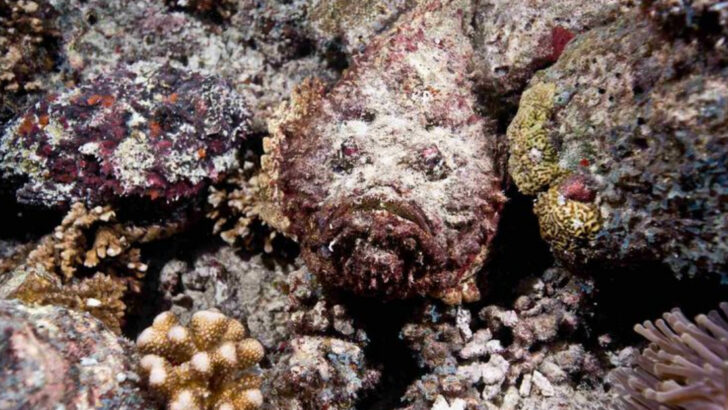The ocean is full of tricksters—and not the playful kind. Some creatures vanish before your eyes, melting into coral, rock, or sand without a trace. Others change shape, shift color, or sprout fake eyes just to confuse their enemies (or lunch). This isn’t just survival. It’s art. And evolution has created some true masters of disguise in the deep. From shape-shifting octopuses to transparent predators, these animals don’t just hide—they perform. And once you learn how they do it, you’ll never look at the ocean the same way again. Let’s dive into the world of camouflage, trickery, and unbelievable animal illusions.
Mimic Octopus

The mimic octopus, a true chameleon of the sea, can impersonate up to fifteen different marine creatures. With a twist of its arms and a change in color, it can transform into a venomous lionfish, a flatfish, or even a sea snake. This remarkable ability confuses predators, offering the octopus a chance to escape. Found in the Indo-Pacific region, the mimic octopus is a master of deception. Its ability to mimic other animals not only provides protection but also aids in hunting. Truly, it is one of nature’s most versatile illusionists.
Leafy Sea Dragon

The leafy sea dragon, a relative of the seahorse, is adorned with leaf-like appendages that allow it to hide among seaweed and kelp. Its intricate camouflage is so effective that it appears to be a floating piece of seaweed in the water. Found off the southern and western coasts of Australia, this creature relies heavily on its appearance to avoid predators. Aside from its camouflage, the leafy sea dragon is known for its leisurely pace, drifting with the currents. This slow-moving beauty is a marvel of evolutionary adaptation.
Cuttlefish

Cuttlefish are renowned for their extraordinary ability to change color and texture with astonishing speed. Using specialized cells in their skin, they can produce a wide range of colors and patterns to communicate or blend into their surroundings. Often found in coral reefs, these intelligent cephalopods use their camouflage both for hunting and hiding. Their ability to mimic the ocean floor or nearby rocks is unmatched. Known for their intelligence, cuttlefish can solve complex puzzles. This adaptability makes them fascinating subjects of scientific study.
Stonefish

The stonefish, armed with venomous spines, is one of the ocean’s most dangerous residents. Its bumpy, rock-like appearance allows it to lie undetected on the ocean floor, waiting for prey to venture too close. Found primarily in the Indo-Pacific oceans, the stonefish’s camouflage is its primary hunting tool. Its ability to remain perfectly still, coupled with its deadly defense mechanism, makes it a formidable predator. Despite its fearsome reputation, the stonefish is a marvel of natural engineering, perfectly adapted to its environment.
Sea Cucumber

Sea cucumbers, often overlooked, are masters of disguise in the oceanic world. Their elongated bodies and drab colors allow them to blend seamlessly into sandy or rocky ocean floors. Found in oceans worldwide, these creatures play a vital role in the marine ecosystem by recycling nutrients. Beyond their camouflage, sea cucumbers can expel their internal organs to deter predators, regenerating them later. This unique defense mechanism, combined with their ability to blend in, makes them fascinating subjects of study and observation.
Flounder

The flounder, with its flat body and both eyes on one side, is an expert at lying low. Its mottled skin blends perfectly with sandy or muddy ocean floors, making it nearly invisible to predators and prey alike. Found in coastal waters worldwide, the flounder’s ability to change its skin color to match its surroundings is remarkable. This adaptive camouflage not only aids in hunting but also provides protection from larger marine predators. Flounders begin life with eyes on both sides, which migrate as they mature.
Decorator Crab

Decorator crabs are the ocean’s creative camouflage artists. These crabs attach bits of seaweed, shells, and other debris to their shells, creating a moving masterpiece of disguise. Found in various marine environments, they use this technique to avoid predators. Each crab’s decoration is unique, tailored to its specific habitat. This crafty behavior demonstrates a fascinating blend of instinct and adaptability, allowing the decorator crab to thrive in its underwater world. Their ingenuity showcases the incredible diversity of survival strategies in nature.
Lionfish

The lionfish, with its striking striped pattern, is both beautiful and deadly. Native to the Indo-Pacific, it’s known for its venomous spines and bold appearance. Its stripes serve as both camouflage and warning, helping it to ambush prey and deter predators. The lionfish’s ability to blend into coral reefs makes it a successful hunter. Unfortunately, in regions where it has been introduced, it’s considered an invasive species due to its voracious appetite and lack of natural predators. Despite its impact, it’s a stunning example of natural artistry.
Sea Horse

Sea horses, with their delicate frames and prehensile tails, are experts at blending into seagrasses and corals. Found in shallow tropical and temperate waters, their ability to change color aids in camouflage and social interactions. These unique fish use their tails to anchor themselves to vegetation, reducing the chance of being swept away by currents. Sea horses are also known for their unusual reproductive role reversal, with males carrying the young. Their charming appearance and lifestyle make them a favorite among marine enthusiasts.
Scorpionfish

Scorpionfish are masters of disguise, with their spiky bodies and mottled skin allowing them to disappear among the coral reefs. Found in tropical waters, these venomous fish rely on their camouflage to ambush unsuspecting prey. Their ability to remain motionless and virtually undetectable makes them formidable hunters. The scorpionfish’s venomous spines also provide a powerful deterrent to potential predators. Despite their dangerous nature, these fish are a testament to the intricate and beautiful adaptations found in marine life.
Peacock Flounder

The peacock flounder, with its eye-catching blue and brown patterns, is a master of adaptation. Its ability to change color and pattern to match its surroundings is unparalleled. Found primarily in the warm waters of the Indo-Pacific, this flatfish’s unique appearance allows it to blend effortlessly into sandy and rocky substrates. Its mobile eyes can independently scan for threats or food, enhancing its survival. The peacock flounder’s remarkable camouflage and strategic hunting tactics make it a fascinating subject for marine biologists.
Ghost Pipefish

Ghost pipefish, with their delicate, elongated bodies, are enchantingly elusive. Their translucent and patterned bodies allow them to blend seamlessly with the soft corals and seagrasses they inhabit. Found in the Atlantic, Indian, and Pacific Oceans, these fish are often mistaken for floating sea debris. Their mimicry aids in avoiding predators and ambushing prey. Ghost pipefish are closely related to seahorses, sharing many characteristics, including unusual reproductive roles. Their ethereal beauty and unique adaptations captivate divers and marine biologists alike.
Common Sole

The common sole, a flatfish found in European waters, excels at disappearing into sandy ocean floors. Its ability to change skin color, combined with a flat body, makes it nearly invisible to both predators and prey. This camouflage allows the sole to lie in wait, ambushing small fish and invertebrates. Known for its culinary value, the common sole is a popular target for fishermen. Its subtle elegance and stealthy hunting tactics highlight the incredible adaptability of marine life, ensuring its survival in diverse habitats.
Weedy Sea Dragon

The weedy sea dragon is an exquisite marvel of nature, resembling a piece of floating seaweed. Its leaf-like appendages provide exceptional camouflage among kelp and seagrasses. Found along the southern and eastern coasts of Australia, this relative of the seahorse is a master of disguise. Unlike many marine animals, the weedy sea dragon is not a strong swimmer, relying on its unique appearance for survival. Its fascinating life cycle and captivating appearance make it a favorite among marine enthusiasts and conservationists.
Chameleon

Chameleons are nature’s most celebrated masters of camouflage. These lizards can change their skin color for communication, temperature regulation, and blending into their surroundings. Found in rainforests and deserts, chameleons use their long, sticky tongues to snatch prey with precision. Their independently moving eyes give them a 360-degree field of vision, enhancing their hunting and survival skills. Known for their slow, deliberate movements, chameleons are fascinating creatures that captivate enthusiasts and scientists alike. Their color-changing ability is a testament to nature’s ingenuity.
Stick Insect

Stick insects are renowned for their remarkable resemblance to twigs and branches, a perfect defense against predators. These insects are found in various habitats, from tropical rainforests to temperate regions. Their long, slender bodies and muted colors allow them to blend seamlessly into their environment. Stick insects remain motionless during the day, feeding on leaves at night. Some species can even regenerate lost limbs. This incredible mimicry and adaptability make stick insects a favorite subject for entomologists and nature enthusiasts.
Leaf-Tailed Gecko

Leaf-tailed geckos are masters of disguise, with their tails resembling dead leaves to avoid detection by predators. Found in Madagascar, these geckos use their incredible camouflage to blend into tree trunks and foliage. Their broad bodies and leaf-like tails create an almost invisible profile. This adaptation, along with their nocturnal habits, helps them evade predators. Despite their elusive nature, leaf-tailed geckos are popular among reptile enthusiasts. Their unique appearance and survival tactics highlight the incredible diversity of life on Earth.
Potoo Bird

The potoo bird is an enigmatic creature, known for its exceptional camouflage among tree branches. Found in Central and South America, these nocturnal birds are often mistaken for part of the tree. Their mottled feathers and still posture make them nearly invisible during the day. Potoos feed on insects at night, using their large mouths to catch prey mid-flight. Their haunting calls and unique appearance have intrigued birdwatchers and researchers alike. The potoo’s mysterious existence underscores the wonders of avian adaptation.
Leaf-Mimic Katydid

Leaf-mimic katydids are remarkable insects that perfectly resemble leaves, complete with veins and imperfections. Found in tropical forests, their disguise is so convincing that they are often overlooked by predators. These katydids are primarily nocturnal, feeding on leaves and using their camouflage to avoid detection. Their ability to imitate leaves demonstrates nature’s incredible ingenuity and adaptability. Leaf-mimic katydids are a favorite among entomologists, who study their behavior and role in the ecosystem. Their lifelike appearance continues to fascinate and inspire awe.
Orchid Mantis

The orchid mantis is a stunning insect that resembles the delicate petals of an orchid flower. Found in the rainforests of Southeast Asia, this mantis uses its floral disguise to ambush unsuspecting prey. Its pink and white coloring, combined with petal-like limbs, make it a master of deception. The orchid mantis’s hunting strategy relies on its ability to remain motionless, waiting for insects to approach. This remarkable mimicry not only aids in predation but also protects it from predators. It’s a living masterpiece of evolutionary design.

